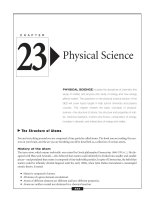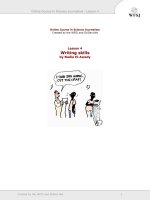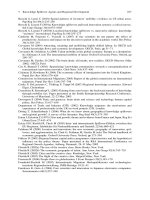4 14 movie science (physical science)
Bạn đang xem bản rút gọn của tài liệu. Xem và tải ngay bản đầy đủ của tài liệu tại đây (4.4 MB, 14 trang )
Genre
Nonfiction
Comprehension Skill
Draw Conclusions
Text Features
• Captions
• Call Outs
• Text Boxes
• Glossary
Science Content
Sound and Light
Scott Foresman Science 4.14
ISBN 0-328-13900-9
ì<(sk$m)=bdja c< +^-Ä-U-Ä-U
Vocabulary
Extended Vocabulary
absorption
compression
frequency
opaque
pitch
reflection
refraction
translucent
transparent
wavelength
animation
blue screen
boom
cel
praxinoscope
shutter
splicing
sprockets
Picture Credits
Every effort has been made to secure permission and provide appropriate credit for photographic material.
The publisher deeply regrets any omission and pledges to correct errors called to its attention in subsequent editions.
Photo locators denoted as follows: Top (T), Center (C), Bottom (B), Left (L), Right (R), Background (Bkgd).
4 (BR) Science Museum, London/DK Images; 5 (BR) Science Museum, London/DK Images; 16 Dreamworks LLC/The Kobal
Collection; 18 (B) Getty Images; 21 (T) Bravo Post Production, London; 22 Touchstone/Jerry Bruckheimer Inc./The Kobal
Collection; 23 The Cinema Museum/Ronald Grant Archive.
Scott Foresman/Dorling Kindersley would also like to thank: 4 (BL) Science Museum/DK Images; 20 (BL, BCL, BCR, BR)
©Hibbert/Ralph/DK Images; 21 (BL, BC, BR) ©Hibbert/Ralph/DK Images.
Unless otherwise acknowledged, all photographs are the copyright © of Dorling Kindersley, a division of Pearson.
ISBN: 0-328-13900-9
Copyright © Pearson Education, Inc. All Rights Reserved. Printed in the United States of America.
This publication is protected by Copyright, and permission should be obtained from the publisher prior to any
prohibited reproduction, storage in a retrieval system, or transmission in any form by any means, electronic,
mechanical, photocopying, recording, or likewise. For information regarding permission(s), write to
Permissions Department, Scott Foresman, 1900 East Lake Avenue, Glenview, Illinois 60025.
3 4 5 6 7 8 9 10 V010 13 12 11 10 09 08 07 06 05
What did you learn?
1. What were some early machines that led
to the first movie cameras?
2. How did early film cameras record images
in color?
3. What is the role of the sound engineer
on a movie? by Sam Brelsfoard
4.
A praxinoscope
showed images that appeared to be
moving. Describe how this machine
worked. Include details from the book
to support your answer.
5.
Draw Conclusions Why do editors
and directors have to edit a movie?
What You Already Know
Sound is a form of energy that travels in waves.
Sound is produced when objects vibrate. When sound
vibrations travel through air, they cause the air particles
to form a pattern. The area of the wave where the
particles are bunched together is a compression.
Some waves move in transverse waves. Sound moves
in longitudinal waves. The frequency of a wave is the
number of waves that pass a point in a certain amount
of time. The faster the wave moves, the higher the
frequency is. A wavelength is the distance between a
point on one wave and a similar point on the next wave.
Sound can move through solids, liquids, and gases.
Sound cannot move through a vacuum, or empty space.
One characteristic of sound is loudness. Loudness
measures how strong a sound seems. Pitch is another
characteristic. Pitch is what makes a sound seem high or
low. Objects that vibrate slowly have a low pitch, and
those that vibrate quickly have a high pitch. Musical
instruments can produce sounds with different pitches.
Light is also energy that moves in waves. White light
passing through a prism splits into the colors of the
visible spectrum. Radio waves, microwaves, and infrared
waves are invisible light waves.
2
Light reflection occurs when light rays bounce off a
surface. Absorption occurs when an object takes in light,
and the light becomes heat energy.
A transparent material lets light rays pass through it. A
translucent material lets only some light rays pass through.
An opaque material does not let any light rays pass through.
Light bends when it moves at an angle from one
medium to another. This bending is called refraction.
Lenses are curved pieces of glass or plastic that refract
light that passes through them. Light bends toward the
middle of a convex lens. Light spreads out when it passes
through a concave lens.
Light and sound energy can be used in many ways. In
this book, you will learn about an entertaining use for
light and sound—movies!
Prisms split white light into different colors.
3
Light Pictures
The technology needed for making the movies we
see today would not have been possible without the
invention of the camera. A camera lens takes in beams
of light that bounce off objects. The beams bend as they
enter the lens, and an upside-down image is projected
onto the camera’s film. Chemicals in the film react to
light and form an image.
By reversing the process of taking a photograph, an
image can be projected on a screen. To do this, light is
shone through the film and then through a lens. The lens
projects the image from the film onto a screen.
The magic lantern was invented in the 1600s. Images
were drawn and painted by hand on small pieces of
glass. The magic lantern projected these images onto a
large screen using light from an oil lamp.
Toward the end of the 1800s, the magic lantern was
being used to entertain huge crowds in the United
States. The hand-drawn pieces of glass were replaced
with photographs. For many years, this was the only
kind of projection equipment available. As photography
became more popular, it became easier to produce these
images. Eventually motion pictures, or movies, took the
place of the magic lantern.
Magic lanterns provided
early picture shows.
light rays reflected
from plant
upside-down image
lens
Early cameras projected
upside-down images.
4
5
Images in Motion
How to make a flip book
When you watch a movie, what you are really
watching is a series of thousands of images flickering
in front of your eyes. This rapid flickering happens so
quickly that you do not see each individual image. Your
brain puts the images together. You see the illusion of
movement on the screen. This illusion is known as
animation. This technology was used in many devices in
the nineteenth century. One of these devices was known
as the praxinoscope.
viewing hole
candle provides
light
The praxinoscope
was a nineteenth century
invention designed
to show moving pictures.
strip of images
rotates
viewer sees
reflections
in mirrors
6
Take a small stack of paper. On the top page,
draw a picture you would like to animate,
such as a bird in the sky. On the next
page, draw the same picture but
make it slightly different. The
bird could be in a different
position on this page. After
you’ve drawn on each page
in the stack, flip through
the pages very quickly.
The picture will seem
to move!
The praxinoscope was a device that produced images
that seemed to move. It had a short, wide tube that
revolved. On the inside wall of the tube was a series of
images. In the middle of the tube was a series of mirrors.
The number of mirrors in the praxinoscope equaled the
number of images. As the tube rotated, the drawings
passed in front of the mirrors. When the tube spun fast
enough, the images seemed to move. A candle above the
tube supplied light. The viewer looked through a hole on
one side to see the series of images forming an animation.
This technology would soon merge with the
technology of cameras. This led to the invention of
cameras that could record movement.
7
Movie Cameras
The first movie cameras were surprisingly small and
lightweight. The film in a movie camera winds from one
reel onto another reel. Film is a long strip of very
strong, thin plastic that is coated with light-sensitive
chemicals. The film is threaded through the camera. It is
guided by sprockets. Sprockets are gearlike wheels. Their
teeth fit into the small holes along the sides of the film.
Many early cameras, including the Debrie Parvo camera,
used a crank to turn the film once it was threaded.
How cameras work
A shutter is a device on a camera that opens and
closes. It controls how much light comes through the
lens. When the shutter closes, a claw moves forward
and catches the holes on the side of the film. This
pulls the film down. The shutter then opens again.
claw
film
shutter
The Debrie Parvo camera was used by many
filmmakers in the early 1900s.
crank
simple lens
Rotating sprockets move the film through the
camera. The film passes in front of the lens. The film
is divided into sections called frames. A shutter opens
as each frame passes in front of the lens. When the
shutter opens, light can reach the film. Twenty-four
images per second are captured on the film. Just as
you saw in the flip book, each image is slightly
different than the one that came before it. This
causes the illusion of movement.
frame
sprocket hole
8
9
At the Movies
How a projector works
A modern film projector in a movie theater uses very
powerful electric lamps to generate light. The projector
uses sprockets to push and pull the film, just as a movie
camera does. The film passes in front of the shutter.
Light shines through it, and images are projected onto
a screen.
Projectors have many parts. The lamphouse holds
the light source. The images are projected through the
lens. The spool cover holds the reels of film.
Inside a movie projector, a
light beam shines past the
shutter through a moving
strip of film. The lens
projects the series of
images onto a screen.
lens focuses
light
As movies developed,
projectors became larger
and more advanced.
sound unit
lens
spool cover
10
magnified
image
shutter blocks light
lamp
lamphouse
film spool
A strip of film holds more than just the images it has
recorded. It often contains the sound for the movie as
well. The sound is located on the side of the film next to
the images. A sound unit on the projector picks up the
sounds. It changes the sound information into electrical
signals and sends them out to the speakers in the movie
theater. The speakers turn those signals into the sound
that you hear. Because the sound information and the
images are on the same piece of film, you hear the sound
and see the images at the same time.
11
Cinema in Color
The primary colors of light are red, blue, and green.
When you mix these colors in specific amounts, you can
make any other color you want. White light is all colors
of the visible spectrum put together. In order for movie
cameras to properly record the images in front of them,
the film must be able to record all of the right color
information. Modern movie cameras use film with
layers of chemicals that are sensitive to red, blue, and
green light. This ensures that the camera will record
every color combination of light that enters the lens.
White light is made
up of all the colors
in the spectrum.
blue light
Early film cameras were not able to record different
colors. So the movies they recorded were black and
white. Soon the technology became available to make
movies in color. Some of the first color cameras that
were invented used a prism to record all of the color
information on the film. When white light enters a
prism, it splits into all its different colors. The prism
in the camera caused light to split and enter the lens as
three separate colors: red, blue, and green. Each color
was put on its own reel of film. In order to show the
film in theaters, the colors had to be combined again.
The three rolls of film were processed to make one
final full-color reel that could be projected with
regular projectors.
green light
Early color cameras
recorded colors using
a prism.
cyan
magenta
red light
white light
yellow
12
13
Sound
Sound engineers are the people on
a movie set who record the actors’
voices, as well as any other sound that
is in the movie. The engineers use a
large, powerful microphone to capture
sound. The sound is then saved on a
portable recording device. Usually
when engineers are recording sound
on a movie set, they will put the
Sound is sometimes
microphone at the end of a long
recorded with
a hand-held
mechanical arm called a boom. This
keeps the microphone out of the view microphone.
of the camera while still recording the
necessary sounds. Sometimes, if the sound the engineers
are trying to capture comes from something that moves
throughout the scene, they use a hand-held microphone.
This is a microphone that is attached to the end of a
pole. It is moved to follow the sound source.
On a film set, sound is
recorded using a long
mechanical arm known
as a boom.
14
Microphones pick up sound waves in the air and
change them into electric signals. These sound signals
travel through wires in the microphone to the sound
engineers’ portable recording device. There they are
stored. Later they are carefully lined
up with the images that the
camera has recorded.
boom supports
microphone
camera
15
Mixing Sound
Most movies have many sounds: dialogue, sound
effects, music, and background noises. All of these
sounds must be combined to play along with the movie.
Usually each sound is recorded separately. What the
actors say, the dialogue, is recorded on the set during
filming or later in a sound studio. The background
sounds can be recorded with or without the actors being
present. The sound effects are usually recorded after the
scene has been filmed. The music for the movie is often
the last part to be recorded.
Dialogue recorded
after filming is called
a voice-over.
16
The audio technician sits at a control panel
to put together the final sound for the film.
Once all the sounds have been recorded, it is the
work of the audio technicians to mix the sounds
together. They use special audio equipment to do this.
The technicians’ main job is to adjust the volume and
quality of the sound to make it work well with the
movie. They make sure that all the sounds are heard at
exactly the right moments.
When the technicians have finished mixing the
sounds, they record the complete, final version. This is
then added to the side of the final version of the film as
a series of magnetic stripes. When the film is played in
movie theaters, the sound and the images match up.
17
Editing the Film
Once all of the movie has been
filmed and all of the sound has been
recorded, the director and the film
editor must edit the film. Often, the
scenes in a movie have been filmed
out of order. This means that when
filming is completed, the director and
editor have many rolls of film that
must be placed in the right order
to make the movie.
Film editors once
used a machine
called a film splicer.
Today film is fed into computers and edited digitally.
Sometimes many different versions of the same
scenes are recorded. The director and the editor spend
many hours watching the film and choosing the best
versions from what they recorded. They put the scenes
in order, cut out the unnecessary parts, and assemble the
film. When they are finished, a new roll of film is made
that holds the final version of the movie. It is wound
onto spools and sent to theaters.
Today computers are used to edit films. Unedited
film is fed into a computer. Editors can use the computer
to change the film however they wish. The use of
computers is a relatively new tool in editing. In the past,
editors worked with the actual pieces of film. In order to
cut a scene, an editor used a film splicing machine. This
machine cut the film at the desired spot and reconnected
the pieces that were left. The editors then threw away the
unwanted pieces of film. This was a very time-consuming
process. Computers make it much easier for editors and
directors to edit their movies.
The final film is
wound onto spools.
18
19
Animation
An animated film contains thousands of drawings.
In early animated movies, every drawing that you saw
on the screen had been drawn by hand. Every scene in
an animated movie is carefully planned before any
drawing is done. To reduce the amount of drawing
each artist has to do, scenes are planned where the
backgrounds stay the same. The detailed background is
drawn once, and the animated characters are placed on
top of it. To do this, the characters that will be placed
on top of the background are drawn on a clear piece of
film known as a cel. Each action that the character
makes is drawn on a fresh cel. The cels are then placed
on top of the background and photographed
individually. When the film is played back it looks as if
the character and the background are the same drawing.
The different layers of animation help make the film
appear three-dimensional, or 3-D, instead of flat and
two-dimensional. It looks more realistic.
Many animated movies now use computers
to create 3-D digital animation.
Most of today’s animated films are made using
computers. Much of the drawing is done on computers,
so animators are free to concentrate on other areas of
the film. This does not mean that computer animation is
any easier. It is simply a different approach to an old
idea. Computer animators are skilled technicians who
understand the many uses of very advanced software
that can help them make animated movies.
Animation is made up
of many layers.
20
21
Special Effects
New technology is being developed in the movie
industry every day. The blue screen is a technique that
caught people’s attention when it was first invented. By
filming characters in front of a large blue screen, movie
editors can later replace the image of the blue screen in
the background with anything they want. By replacing
the blue screen with stars and planets, for example,
filmmakers can make it seem as though characters are
flying through space. This sort of technology allows us
to see things that seem impossible.
Blue screens enable many
special effects.
People have been going to the movies for many years.
What will movies of the future be like?
Many films use computer-generated imagery, or CGI,
to make special effects. CGI can be used to make it seem
as if one character turns into another. Combining CGI
and regular film footage can make it seem as though
almost anything were possible.
The way we make and watch movies changes all the
time. Computers and special effects have changed the
way films are made. Digital projectors and DVDs are
changing the way we watch movies. We can only guess
what’s in store for the future of moviemaking. One
thing we can count on is that the science behind
moviemaking will keep developing and changing to
make movies even more entertaining.
22
23
Vocabulary
Glossary
absorption
compression
animation
frequency
opaque
pitch
blue
screen
reflection
refraction
translucent
transparent
boom
wavelength
Extended Vocabulary
animation
blueof
screen
the production
the illusion of
boom
moving images
cel
technologypraxinoscope
in which subjects are filmed
shutter
in front of a blue-colored screen that
splicing
can be replaced
with other images
sprockets
a mechanical arm that holds a
microphone
cel
a clear piece of film on which a
character is drawn and then placed
over a background illustration
praxinoscope
an early device that gave the illusion
of images in motion
Picture Credits
Every effort has been made to secure permission and provide appropriate credit for photographic material.
The publisher deeply regrets any omission and pledges to correct errors called to its attention in subsequent editions.
shutter
part of a camera that opens and closes
4 (BR) Science Museum, London/DK Images;
5 (BR) Sciencehow
Museum,much
London/DK light
Images; 16comes
Dreamworks LLC/The Kobal
to control
Collection; 18 (B) Getty Images; 21 (T) Bravo Post Production, London; 22 Touchstone/Jerry Bruckheimer Inc./The Kobal
Collection; 23 The Cinema Museum/Ronald
Grant Archive.
through
the lens
Photo locators denoted as follows: Top (T), Center (C), Bottom (B), Left (L), Right (R), Background (Bkgd).
Scott Foresman/Dorling Kindersley would also like to thank: 4 (BL) Science Museum/DK Images; 20 (BL, BCL, BCR, BR)
©Hibbert/Ralph/DK Images; 21 (BL, BC, BR) ©Hibbert/Ralph/DK Images.
splicing
joining two objects together, such as
pieces of film
Unless otherwise acknowledged, all photographs are the copyright © of Dorling Kindersley, a division of Pearson.
sprockets
gearlike wheels with teeth that fit into
Copyright © Pearson Education, Inc. All
Rights
Reserved.holes
Printed in the
of America.
the
small
onUnited
theStates
sides
of film
This publication is protected by Copyright, and permission should be obtained from the publisher prior to any
ISBN: 0-328-13900-9
prohibited reproduction, storage in a retrieval system, or transmission in any form by any means, electronic,
mechanical, photocopying, recording, or likewise. For information regarding permission(s), write to
Permissions Department, Scott Foresman, 1900 East Lake Avenue, Glenview, Illinois 60025.
3 4 5 6 7 8 9 10 V010 13 12 11 10 09 08 07 06 05
24
What did you learn?
1. What were some early machines that led
to the first movie cameras?
2. How did early film cameras record images
in color?
3. What is the role of the sound engineer
on a movie?
4.
A praxinoscope
showed images that appeared to be
moving. Describe how this machine
worked. Include details from the book
to support your answer.
5.
Draw Conclusions Why do editors
and directors have to edit a movie?









